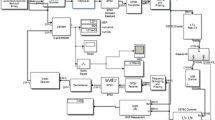Abstract
Beam-space multiple-input and multiple-output (BS-MIMO) system is proved to be able to support MIMO transmission using a single active antenna, which is different from the conventional MIMO system. The conventional MIMO system has to use multiple RF chains to transmit multiple streams. Due to this benefit characteristic, there is no correlation and coupling problem. Also, the hardware complexity of the system is drastically reduced in comparison with the conventional MIMO system. Eventually, it is possible to miniaturize the antenna size. However, there are very few researches on the orthogonal frequency division multiplexing (OFDM) transmission based on this BS-MIMO system. Therefore, we propose the OFDM transmission based on BS-MIMO system and analyze performance of the proposed system. The proposed system has little bit degradation of BER performance in comparison with single carrier based BS-MIMO system. When a power of transmitted OFDM signal is low, the detection error about the direction of the beam pattern at the receiver occurs. In this paper, we improve BER performance of BS-MIMO system by setting thresholds on the transmission power of OFDM signal. As a result, the proposed system with clipping scheme still generates about 2 dB BER performance degradation. However, we can confirm the practical implementation feasibility of OFDM transmission system based on the BS-MIMO system.







Similar content being viewed by others
References
Lizhong, Z., & Tse, D. N. C. (2003). Diversity and multiplexing: a fundamental tradeoff in multiple-antenna channels. IEEE Transactions on Information Theory, 49(5), 1073–1096.
Goldsmith, A., Jafar, S. A., Jindal, N., & Vishwanath, S. (2003). Capacity limits of MIMO channels. IEEE Journal on Selected Areas in Communications, 21(5), 684–702.
Browne, D. W., Manteghi, M., Fitz, M. P., & Rahmat-Samii, Y. (2006). Experiments with compact antenna arrays for MIMO radio communications. IEEE Transactions on Antennas and Propagation, 54(11), 3239–3250.
Chi-Yuk, C., & Murch, R. D. (2008). Compact four-port antenna suitable for portable MIMO devices. IEEE Antennas and Wireless Propagation Letters, 7, 142–144.
Kalis, A. & Papadias C. (2007). An ESPAR antenna for beamspace-MIMO systems using PSK modulation schemes. In IEEE 2007 international conference on communications (ICC ‘07), (pp. 5348–5353). June 24–28, 2007.
Kawakami, H., & Ohira, T. (2005). Electrically steerable passive array radiator (ESPAR) antennas. IEEE Antennas and Propagation Magazine, 47(2), 43–50.
Schlub, R., Junwei, L., & Ohira, T. (2003). Seven-element ground skirt monopole ESPAR antenna design from a genetic algorithm and the finite element method. IEEE Transactions on Antennas and Propagation, 51(11), 3033–3039.
Barousis V., Kanatas A. G., Kalis A. & Papadias C. (2008). A limited feedback technique for beamspace MIMO systems with single RF front-end. In: IEEE 19th international symposium on personal, indoor and mobile radio communications 2008. (PIMRC 2008), September 15–18, 2008.
Alrabadi, O. N., Papadias, C. B., Kalis, A., Marchetti, N., & Prasad, R. (2009). MIMO transmission and reception techniques using three-element ESPAR antennas. IEEE Communications Letters, 13(4), 236–238.
Alrabadi, O. N., Papadias, C. B., Kalis, A., & Prasad, R. (2009). A universal encoding scheme for MIMO transmission using a single active element for PSK modulation schemes. IEEE Transactions on Wireless Communications, 8(10), 5133–5142.
Bo, H., Barousis, V. I., Papadias, C. B., Kalis, A., & Prasad, R. (2013). MIMO over ESPAR with 16-QAM modulation. IEEE Wireless Communications Letters, 2(6), 687–690.
Bains, R., & Muller, R. (2008). Using parasitic elements for implementing the rotating antenna for MIMO receivers. IEEE Transactions on Wireless Communications, 7(11), 4522–4533.
Mesleh, R., Haas, H., Ahn, C. W. & Yun, S. (2006). Spatial modulation: A new low-complexity spectral efficiency enhancing technique. In Proceedings China Com (pp. 1–5). October 25–27, 2006.
Acknowledgments
This research was supported by Basic Science Research Program through the National Research Foundation of Korea(NRF) funded by the Ministry of Education, Science and Technology (No. 2013R1A2A2A0 1005849) and this work was supported by the ICT R&D program of MSIP/IITP. (14-000-04-001, Development of compact MIMO antennas)
Author information
Authors and Affiliations
Corresponding author
Rights and permissions
About this article
Cite this article
An, C., Ryu, HG. Design and Performance Analysis of Beam-Space MIMO System for Multi-carrier Transmission. Wireless Pers Commun 85, 1573–1582 (2015). https://doi.org/10.1007/s11277-015-2856-6
Published:
Issue Date:
DOI: https://doi.org/10.1007/s11277-015-2856-6




